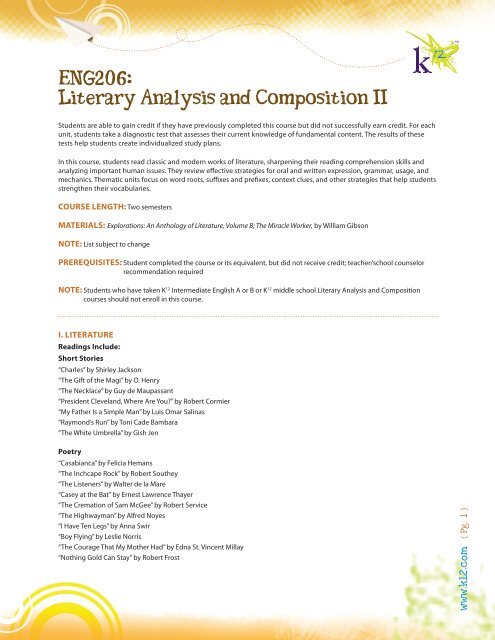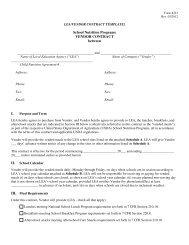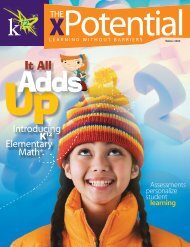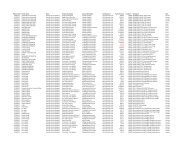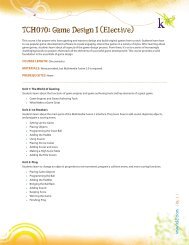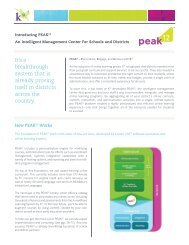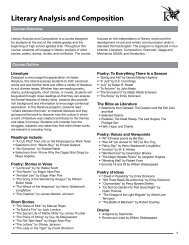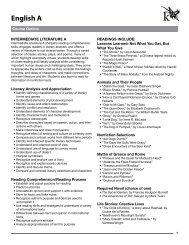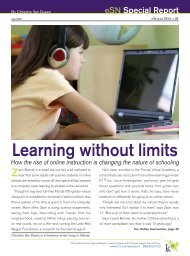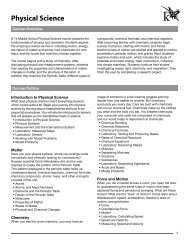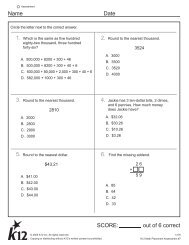ENG206: Literary Analysis and Composition II - K12.com
ENG206: Literary Analysis and Composition II - K12.com
ENG206: Literary Analysis and Composition II - K12.com
- No tags were found...
Create successful ePaper yourself
Turn your PDF publications into a flip-book with our unique Google optimized e-Paper software.
<strong>ENG206</strong>:<strong>Literary</strong> <strong>Analysis</strong> <strong>and</strong> <strong>Composition</strong> <strong>II</strong>Students are able to gain credit if they have previously completed this course but did not successfully earn credit. For eachunit, students take a diagnostic test that assesses their current knowledge of fundamental content. The results of thesetests help students create individualized study plans.In this course, students read classic <strong>and</strong> modern works of literature, sharpening their reading comprehension skills <strong>and</strong>analyzing important human issues. They review effective strategies for oral <strong>and</strong> written expression, grammar, usage, <strong>and</strong>mechanics. Thematic units focus on word roots, suffixes <strong>and</strong> prefixes, context clues, <strong>and</strong> other strategies that help studentsstrengthen their vocabularies.Course length: Two semestersMaterials: Explorations: An Anthology of Literature, Volume B; The Miracle Worker, by William GibsonNote: List subject to changePrerequisites: Student completed the course or its equivalent, but did not receive credit; teacher/school counselorrecommendation requiredNote: Students who have taken K 12 Intermediate English A or B or K 12 middle school <strong>Literary</strong> <strong>Analysis</strong> <strong>and</strong> <strong>Composition</strong>courses should not enroll in this course.I. LITERATUREReadings Include:Short Stories“Charles” by Shirley Jackson“The Gift of the Magi” by O. Henry“The Necklace” by Guy de Maupassant“President Clevel<strong>and</strong>, Where Are You?” by Robert Cormier“My Father Is a Simple Man” by Luis Omar Salinas“Raymond’s Run” by Toni Cade Bambara“The White Umbrella” by Gish JenPoetry“Casabianca” by Felicia Hemans“The Inchcape Rock” by Robert Southey“The Listeners” by Walter de la Mare“Casey at the Bat” by Ernest Lawrence Thayer“The Cremation of Sam McGee” by Robert Service“The Highwayman” by Alfred Noyes“I Have Ten Legs” by Anna Swir“Boy Flying” by Leslie Norris“The Courage That My Mother Had” by Edna St. Vincent Millay“Nothing Gold Can Stay” by Robert Frostwww.k12.com { Pg. 1 }
“A Poison Tree” by William Blake“Beauty” by E-Yeh-Shure’“Barter” by Sara Teasdale“All the world’s a stage” (from As You Like It) by William Shakespeare“The Wind Began to Rock the Grass” by Emily Dickinson“I’ll Tell You How the Sun Rose” by Emily Dickinson“There Is No Frigate Like a Book” by Emily Dickinson“Harlem [2]” by Langston Hughes“Hold Fast Your Dreams” by Louise DriscollDramaThe Miracle Worker by William GibsonNovels (choose two of the following)Jesse by Gary SotoFahrenheit 451 by Ray BradburyLet the Circle Be Unbroken by Mildred TaylorThe Pearl by John SteinbeckPartial List of Skills Taught:• Describe characters based on speech, actions, or interactions with others.• Demonstrate knowledge of authors, characters, <strong>and</strong> events of works of literature.• Identify, analyze, interpret, <strong>and</strong> discuss the following elements of literature:– character traits <strong>and</strong> motivations– allusions– conflict <strong>and</strong> resolution– irony– figurative language, imagery, <strong>and</strong> sensory language– point of view– author’s attitude or tone– elements of plot• Identify, analyze, <strong>and</strong> discuss elements of a drama.• Identify analyze, <strong>and</strong> discuss elements of a short story.• Identify, analyze, <strong>and</strong> discuss theme in literary works.• Identify cause-<strong>and</strong>-effect relationships.• Make inferences <strong>and</strong> draw conclusions.• Recognize the effect of setting or culture on a literary work.• Recognize use of language to convey mood.• Discuss author’s purpose <strong>and</strong> analyze literary devices used to accomplish it,including language, organization, <strong>and</strong> structure.• Compare <strong>and</strong> contrast literary characters <strong>and</strong> selections.www.k12.com { Pg. 2 }


